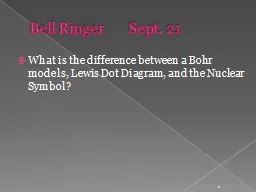

What is the difference between a Bohr models Lewis Dot Diagram and the Nuclear Symbol 1 Periodicity Periodic Trends 2 Periodic Law The chemical and physical properties of the elements are periodic functions of their atomic numbers properties of the elements occurred at repeated interv ID: 555874
Download Presentation The PPT/PDF document "Bell Ringer Sept. 21" is the property of its rightful owner. Permission is granted to download and print the materials on this web site for personal, non-commercial use only, and to display it on your personal computer provided you do not modify the materials and that you retain all copyright notices contained in the materials. By downloading content from our website, you accept the terms of this agreement.
Slide1
Bell Ringer Sept. 21
What is the difference between a Bohr models, Lewis Dot Diagram, and the Nuclear Symbol?
1Slide2
Periodicity
Periodic Trends
2Slide3
Periodic Law
The chemical and physical properties of the elements are periodic functions of their atomic numbers; properties of the elements occurred at repeated intervals called periods.
This defines the property of periodicity
3Slide4
4Slide5
Periodic Trends
properties that show patterns when examined across the periods or vertically down the groups
while there are many periodic trends, we will focus on
atomic radii (the plural of radius)
ionization energy
Electronegativity
Ionic radii (the plural of radius)
5Slide6
Atomic Radii
One half the distance between the nuclei of identical atoms that are bonded together.
Distance between nuclei decreases across periods because the higher nuclear charge (positive) pulls the electrons closer to the nucleus
increases down groups because energy levels are being added outside the nucleus
6Slide7
Atomic Radii Increases
Atomic Radii Decreases
7Slide8
Graphing Atomic radii
The graph of Atomic Radius vs. Atomic Number shows the trend in atomic radius as one proceeds through the first 37 elements in the periodic table
.
8Slide9
Ionization Energy
The energy required to remove one electron from a neutral atom of an element.
increases across periods because it takes more energy to overcome the electrons attraction to the increasing nuclear charge
decreases down groups because it is easier to overcome the nuclear charge for the outermost electrons as the number of energy levels increases
9Slide10
10Slide11
Graphing Ionization Energy
These trends are visible in the graph of ionization energy versus atomic number.
11Slide12
Electronegativity
a measure of the ability of an atom in a compound to attract electrons from other atoms
increases across periods as a result of the increasing nuclear charge and ability of the nucleus to attract electrons from a neighboring atom
decreases down groups because the nuclear charge is less able to attract electrons from another atom as additional energy levels are added
12Slide13
13Slide14
Graphing Electronegativity
The graph of Electronegativity vs. Atomic Number shows the trend in the electronegativity as one proceeds through the first 37 elements in the periodic table.
14Slide15
Ionic Radii
The radius of an atom forming ionic bond or an ion. The radius of each atom in an ionic bond will be different than that in a covalent bond.
The reason for the variability in radius is due to the fact that the atoms in an ionic bond are of greatly different size. One of the atoms is a cation, which is smaller in size, and the other atom is an anion which is a lot larger in size.
15Slide16
decreases across the period until formation of the negative ions then there is a sudden increase followed by a steady decrease to the end
The sudden increase on formation of negative ions is due to the new (larger) outer shell
16Slide17
Graphing ionic radii
17Slide18
Closing Task Sept. 21
Which elements have the highest and lowest atomic radii?
Which elements have the highest and
lowest
electronegativity
?
Which
elements have the highest and
lowest ionization energy?Which elements have the highest and lowest ionic radii?
18